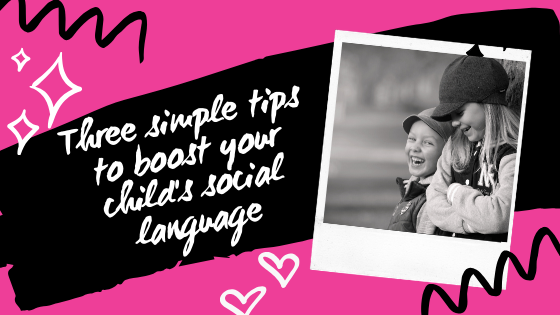Three simple tips to boost your child's social language
- Smarter Speech

- Jun 28, 2020
- 3 min read
Updated: Apr 7, 2022

A child’s ability to empathize is one of the roots of social communication skills. It is the reason why so many social language programs in the field of speech-language pathology are based on identifying thoughts and feelings of others, as well as how to react to them.
So, how do we increase a child's ability to empathize, and the ease with which it is done?
Here are three tips to get started -
1. Practice identifying others’ feelings and why they are feeling that way
A child starts identifying basic feelings such as “happy” and “sad” at as early as 3-4 years old . As they grow older, you can add in “mad”, “scared”, and “tired.” With time, you can make the emotion vocabulary more complex.
Teaching words like “frustrated” or “annoyed” is a great way to increase semantic knowledge. To teach emotion vocabulary, simply model the vocabulary repeatedly. After some time, your child will catch on, and use the words himself.
Once you have the feelings down, you can start adding in “why.” A child can answer simple “why” questions at as early as 4 years old. Again, model the answer. “Why are you feeling sad? Is it because you don’t want to play cars?” Do it a couple of times. And, with time, your child will model the answers. He’ll say “I feel sad because I don’t want to go to school” when you drop him off.
Remember: only when your child is able to identify his emotions can he identify others’ emotions.
2. Practice identifying feelings in others
Once your child can identify and reason out her emotions, you can work on having her identify the same feelings in others.
There are countless opportunities to do this.
You can point out your emotions while you are disciplining. For example, “look at me. How is mommy feeling? Sad. Why am I feeling sad? Because you are not listening.” You can even point out emotions of peers or siblings. “Look at Andrew. How is Andrew feeling? Angry. Why is he feeling angry? Because you took his toy.”
You can point out emotions in TV shows. “How is Dora feeling? Happy. Why is she feeling happy? Because she found the treasure."
Finally, you can even point them out in books “How is Clifford feeling? Tired. Why is he feeling tired? Because he ran all the way home.”
3. Practice identifying how others will feel about your child after your child offers help
Once your child has a grasp on others’ emotions and the reasons behind them, she can start problem solving.
Again, for children around 4 -5 years old who are just developing theory of mind, or the ability to think about others’ thoughts and feelings, this will first be hard work.
However, you can help them along. Start by asking the question. “What can you do to make mommy / Andrew feel better?” or “What can Emily do to make Clifford feel better?” Then pause.
After a while, give a choice. “Can you give the toy back? Or can you say ‘I’m sorry’?” And see if your child picks one.
Finally, provide the model. “You can say ‘I’m sorry.’ Can you say ‘I’m sorry’ please?”
That's all! Just three simple tips. They may seem easy - but it is the frequency and the amount of practice given to these three tips which really determines their efficacy.
The more you practice these –, while watching TV, while people watching, or while reading – the better your child will be able to think like this by herself.
Then, with time, you can generalize this same framework to daily social situations.
Teaching empathy is going to feel a little forced and strange at first. And it is going to take a little work. But you will be helping your child see the world a little differently, and strengthening the base of her social communication skills.
Happy Talking!
Disclaimer : Smarter Speech is a pediatric speech therapy / speech-language pathology practice for toddlers and children providing in-home and teletherapy services in and around Mountain View, CA and Los Gatos, CA. Smarter Speech Blog aims to provide free speech and language tips for parents educators and therapists. However, this post is not providing speech-language pathology services. This is general information, not speech -language pathology or speech therapy. This article does not assume or create a client – SLP relationship. The author is not liable for any losses or damages due to actions or failure to act based on the content in this article. If you need assistance with a child’s speech or language needs, please contact a speech-language pathologist in your area.
.png)



Comments